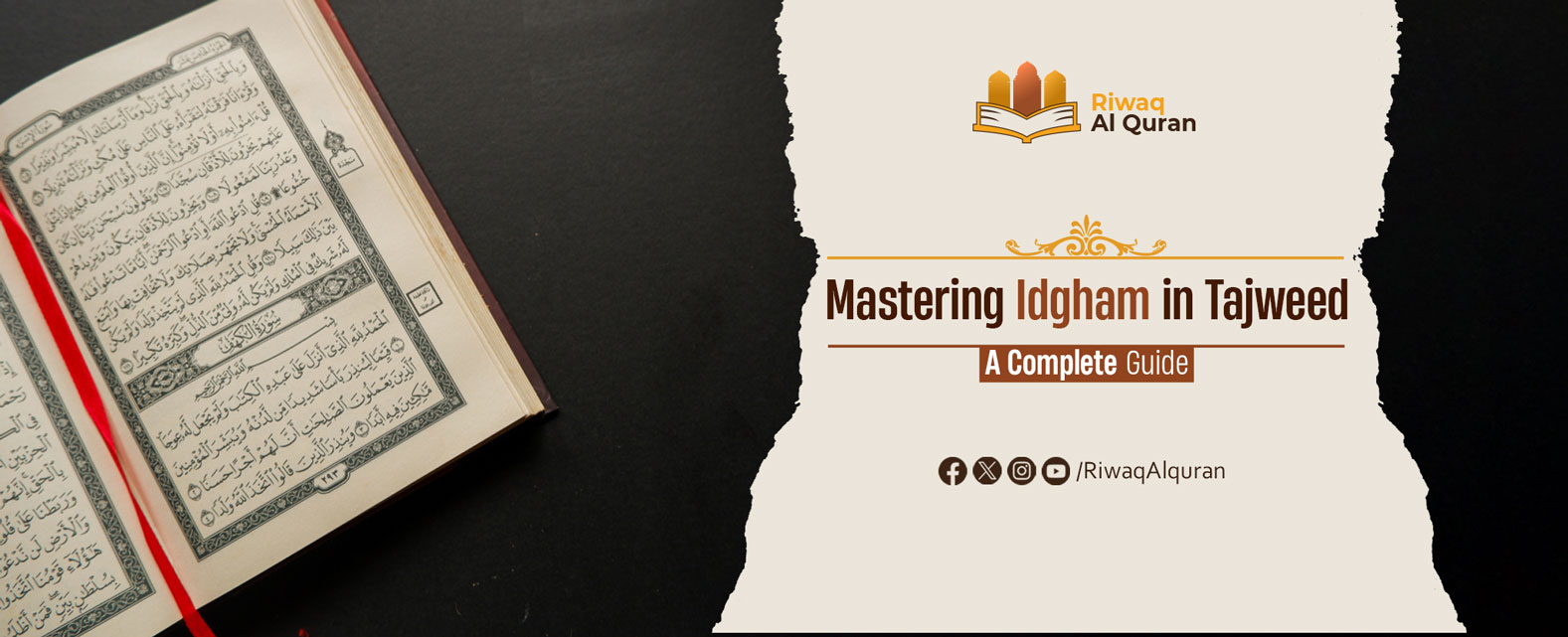Idgham in Tajweed refers to the merging of Noon Sakinah or Tanween with specific letters, making the sound of the following letter dominant. It occurs when these letters (ي, ر, م, ل, و, ن) appear after Noon Sakinah or Tanween, resulting in a smooth blend. There are two types: Idgham with Ghunnah (nasal sound) and without Ghunnah. Idgham with Ghunnah involves a nasal sound and occurs with letters like ي, م, و, and ن, while Idgham without Ghunnah applies to letters like ل and ر, where the Noon sound is dropped without nasalization.
Tajweed refers to the rules for the right pronunciation and recitation of the Holy Quran, which include the utterance and sounds of the letters, opening and hiding them, and more. Following up on our recent articles on Tajweed rules such as the Meem Sakinah rules with examples as well as the rules of Noon Sakinah and Tanween, it is now time to clarify the last topic more to master it.
In Tajweed, there are four rules on what happens when a letter accompanied by Noon Sakinah (نْ) or Tanween is followed by another letter. In both of the rules, Idgham occurs. This post entirely focuses on this branch of Tajweed, i.e., Idgham. To learn what is Idgham in Tajweed and its types in detail, continue reading this post.
Table of Contents
What Is Idgham in Tajweed?
Idgham meaning in English is adding one thing into another. It happens when we categorize objects as having similar characteristics since it is easier for us, in the end, to get what we need. Also, it is easier for the tongue to join two letters and produce the sound of the one with the more dominant characteristic. This is called Idgham.
Read more about: Idgham Shafawi
If you have no prior knowledge about Tajweed and other reading rules, it is advisable to enroll in our Noorani Qaida Online Course to learn how to read the Quran before learning Noon Sakinah and Tanween rules, such as Idgham.
Idgham Definition
When it comes to Quran recitation rules, this term means to merge. Idgham in Tajweed means joining a non-vowel with a vowel so that the two letters become one letter of the second type. Idgham occurs if after Noon Sakinah or Tanween there appear any of the following letters:
- ي
- ر
- م
- ل
- و
- ن
So, If after Noon Sakinah or Tanween comes any of the Idgham letters, Noon Sakinah or Tanween will merge into the letter. The stress will be on the succeeding letter because of the Shadd sign.
To make what is the concept of Idgham clearer, Idgham only occurs when two words are present – the first word will end with a Noon Sakinah or Tanween, and the second word will begin with one of the Idgham letters.


Idgham Letters
These are the letters of Idgham and can be memorized in the form of يَرْمَلُون. As another replacement, an easier phrase that can be used is لر ينمو. The reason to memorize this phrase is due to the fact that this phrase divides the letters of Idgham into letters that will be used for Idgham with Ghunnah (ي ن م و) and without Ghunnah (ل ر).
Pronunciation of Idgham in Tajweed: When and How
The correct pronunciation of Idgham depends on understanding its occurrence and application. Idgham happens when two letters merge seamlessly, producing a fluent sound. The specific technique depends on the type of Idgham and whether it involves Ghunnah, or not. Proper articulation requires recognizing the type of Idgham and practicing until the sounds blend naturally without distortion.
Idgham Types of Noon Sakinah and Tanween
Idgham in Noon Sakinah and Tanween has two types: Idgham with Ghunnah (ي, ن, م, و), where a nasal sound is added during merging, and Idgham without Ghunnah (ل, ر), where merging occurs without nasalization.
1. Idgham with Ghunnah (إدغام بغنة)
The first type is Idgham with nasalization or Idgham Bigunah This type applies with certain letters. If any of these letters appears after Noon Sakinah or Tanween, the Noon Sakinah or Tanween sound will be dropped, and the letter before the Noon Sakinah or the letter having Tanween will merge with the Idgham letter.
Idghaam with Ghunnah Letters
- ي
- ن
- م
- و
2. Idgham Without Ghunnah (إدغام بدون غنة)
There are two letters of Idgham without Ghunnah: Laam (ل) and Raa (ر). Whenever any of these letters come before Noon Sakinah, then Noon Sakinah would be dropped, and the letter coming after Noon Sakinah would join with either Laam or Raa. In this type, in which either the Laam or Raa follow a Tanween, the reciter will not produce the sound NNNNN that arises because of the presence of Tanween.
Idghaam without Ghunnah Letters
- ل
- ر
Other Types of Idgham in Tajweed
Idgham refers to the merging of letters in Tajweed, and there are different types of Idgham in Tajweed, each with its own set of rules. These types are not always related to one specific topic but represent distinct aspects of how letters should be articulated when reading the Quran.
3. Idgham Mutamathilayn (إدغام متماثلين)
If two letters come together, the first being a consonant and the second being a vowel, and they share the same point of articulation and characteristic, it is necessary to assimilate the first into the second. For example:
- اذهب بِّكتابي
- اضرب بِّعصاك
4. Idgham Mutaqaribayn (إدغام متقاربين)
If two letters come together, the first being a consonant and the second being a vowel, and they are close in point of articulation but differ in characteristic, it is necessary to assimilate the first into the second. For example:
- قُل رَّبِ
- بَل رَّفَعَهُ
5. Idgham Mutajanisayn (إدغام متجانسين)
If two letters come together, the first being a consonant and the second being a vowel, and they share the same point of articulation but differ in characteristic, it is necessary to assimilate the first into the second. For example:
- يَلْهَث ذًّلِك
- إذ ظَّلَمُوا
- قَد تَّعْلَمُوَن
- قَالَت طَّائِفَةٌ
6. Idgham Shafawi (إدغام شفوي)
refers to the merging of a silent Meem with a following Meem while maintaining a complete nasal sound. This is illustrated in Idghaam Shafawi examples like:
- ولكم ما كسبتم
- ولهم مغفرة
Experience Riwaq Al Quran Classes
Watch real moments from our live sessions at Riwaq Al Quran and see how we bring learning to life. These clips highlight our interactive, student-focused approach designed to keep learners engaged, motivated, and actively involved in every step of their educational journey.
Idgham Rules
When it comes to Idgham related to Noon Sakinah and Tanween rules, there are some steps to follow to apply Idghaam rules properly with no mistakes:
- Identify if the first letter is Sakinah (with a Sukun).
- Look at the following letter to see if it is suitable for Idgham.
- Check if the following letter is from the Ghunna letters (ن, م, و, ي).
- Determine if the following letter is from the non-Ghunna letters (ل, ر).
- If Ghunna is required, apply a nasal sound while merging the letters.
- If no Ghunna is required, merge the letters without a nasal sound.
- Ensure the pronunciation does not distort the meaning of the words.
- Pay attention to the type of Idgham (full or partial) based on the letters.
- Practice proper blending of the letters without overemphasizing any of them.
Idgham Examples of Noon Sakinah and Tanween
Here are examples of Idgham in the Quran illustrating Idgham with Ghunnah and Idgham without Ghunnah to help understand their application.
1. Idgham with Ghunnah Examples
- أَوْ كَصَيِّبٍ مِنَ السَّمَاءِ فِيهِ ظُلُمَاتٌ وَرَعْدٌ وَبَرْقٌ (Al-Baqarah:19)
- إِذْ أَوَى الْفِتْيَةُ إِلَى الْكَهْفِ فَقَالُوا رَبَّنَا آتِنَا مِنْ لَدُنْكَ رَحْمَةً وَهَيِّئْ لَنَا مِنْ أَمْرِنَا رَشَدًا (Al-Kahf:10)
2. Idgham Without Ghunnah Examples
- أُولَـٰئِكَ عَلَىٰ هُدًى مِنْ رَبِّهِمْ ۖ وَأُولَـٰئِكَ هُمُ الْمُفْلِحُونَ (Al-Baqarah:5)
- وَمَنْ أَضَلُّ مِمَّنْ يَدْعُو مِنْ دُونِ اللَّـهِ مَنْ لَا يَسْتَجِيبُ لَهُ إِلَىٰ يَوْمِ الْقِيَامَةِ (Al-Ahqaf:5)


Why Students Love Learning with Riwaq Al Quran
Hear directly from our students about how Riwaq Al Quran Academy has transformed their connection with the Book of Allah. Their experiences reflect the dedication, care, and quality that guide every step of our teaching.
Join Riwaq Al Quran
At Riwaq Al Quran, our Quran with Tajweed Online Course course, we have made a great effort to make learning Tajweed and Idgham rules way easier for online learners. We try our best to simplify all the Tajweed rules using different examples, activities, and videos. Contact us now to start this rewarding journey and get a free trial class!
We offer several courses such as:
- Online courses for kids.
- Online Quran classes for kids and adults.
- Online Arabic courses
- Online Ijazah courses
- Online Islamic Studies courses.
Here are a sample of our set of Quran Courses that will be helpful for you:
- Online Tafseer Course: Delve into Quranic meanings with our insightful online Tafseer course.
- Noorani Qaida Online: Learn Quranic basics efficiently through our Noorani Qaida online program.
- Online Quran Recitation Course: Enhance Quranic recitation skills through our expert-led online course.
- Online Tajweed Classes: Master Tajweed rules for beautiful Quranic recitation in online classes.
- Quran Memorization Online Course: Memorize the Quran effectively with our specialized online memorization course.
- Online Qirat Course: Explore diverse Qirat styles with our comprehensive online Qirat course.
- Online Quran Classes for Kids: Nurture a love for the Quran in kids through interactive online classes.
Conclusion
Idgham in Tajweed, meaning “merging,” refers to the blending of two letters, one being non-voweled (like Noon Sakinah or Tanween) and the other voweled, into a single sound. This assimilation occurs based on specific rules and letters, such as those in the mnemonic “يرملون.” It is categorized into two primary types: Idgham with Ghunnah (ي, ن, م, و) and Idgham without Ghunnah (ل, ر).
Proper pronunciation depends on recognizing the type of Idgham and practicing the merging technique to ensure fluency without distortion. The concept also extends to other forms like Idgham Mutamathilayn, Mutaqaribayn, Mutajanisayn, and Shafawi, each with distinct articulation rules.
Mastering Idgham is essential for accurate Quranic recitation, as it ensures the proper blending of sounds while preserving the integrity of the text. Examples from the Quran highlight its application, such as in merging Noon Sakinah or Tanween with specific letters.
For learners, understanding these rules can be challenging but rewarding, with structured courses like those at Riwaq Al Quran offering guidance. By following step-by-step instructions, practicing articulation, and applying examples, reciters can achieve clarity and beauty in their recitation.


































